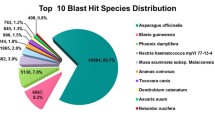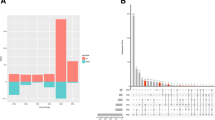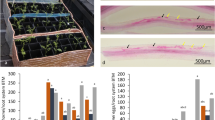Abstract
Root-knot nematodes (RKNs, genus Meloidogyne) affect a large number of crops causing severe yield losses worldwide, more specifically in tropical and sub-tropical regions. Several plant species display high resistance levels to Meloidogyne, but a general view of the plant immune molecular responses underlying resistance to RKNs is still lacking. Combining comparative genomics with differential gene expression analysis may allow the identification of widely conserved plant genes involved in RKN resistance. To identify genes that are evolutionary conserved across plant species, we used OrthoFinder to compared the predicted proteome of 22 plant species, including important crops, spanning 214 Myr of plant evolution. Overall, we identified 35,238 protein orthogroups, of which 6,132 were evolutionarily conserved and universal to all the 22 plant species (PLAnts Common Orthogroups—PLACO). To identify host genes responsive to RKN infection, we analyzed the RNA-seq transcriptome data from RKN-resistant genotypes of a peanut wild relative (Arachis stenosperma), coffee (Coffea arabica L.), soybean (Glycine max L.), and African rice (Oryza glaberrima Steud.) challenged by Meloidogyne spp. using EdgeR and DESeq tools, and we found 2,597 (O. glaberrima), 743 (C. arabica), 665 (A. stenosperma), and 653 (G. max) differentially expressed genes (DEGs) during the resistance response to the nematode. DEGs’ classification into the previously characterized 35,238 protein orthogroups allowed identifying 17 orthogroups containing at least one DEG of each resistant Arachis, coffee, soybean, and rice genotype analyzed. Orthogroups contain 364 DEGs related to signaling, secondary metabolite production, cell wall-related functions, peptide transport, transcription regulation, and plant defense, thus revealing evolutionarily conserved RKN-responsive genes. Interestingly, the 17 DEGs-containing orthogroups (belonging to the PLACO) were also universal to the 22 plant species studied, suggesting that these core genes may be involved in ancestrally conserved immune responses triggered by RKN infection. The comparative genomic approach that we used here represents a promising predictive tool for the identification of other core plant defense-related genes of broad interest that are involved in different plant–pathogen interactions.








Similar content being viewed by others
References
Agrios, GN (2005). Plant diseases caused by nematodes. In: Introduction to plant pathology, fifth ed. Elsevier Academic Press, London pp. 826-872
Albert VA, Barbazuk WB, Der JP, et al (2013) The Amborella Genome and the Evolution of Flowering Plants. Science (80- ) 342
Albuquerque EVS, Carneiro RMDG, Costa PM et al (2010) Resistance to Meloidogyne incognita expresses a hypersensitive-like response in Coffea arabica. Eur J Plant Pathol 127:365–373
Amrine KCH, Blanco-ulate B, Cantu D (2015) Discovery of Core Biotic Stress Responsive Genes in Arabidopsis by Weighted Gene Co-Expression Network Analysis. PloS one, 10(3)
An SH, Sohn KH, Choi HW et al (2008) Pepper pectin methylesterase inhibitor protein CaPMEI1 is required for antifungal activity, basal disease resistance and abiotic stress tolerance. Planta 228(1):61–78
Bacete L (2018) Plant cell wall-mediated immunity : cell wall changes trigger diseas resistanc responses. Plant J 614–636
Beneventi M, da Silva O, de Sa ME et al (2013) Transcription profile of soybean-root-knot nematode interaction reveals a key role of phythormones in the resistance reaction. BMC Genomics 14:322
Bird AF (1961) The ultrastructure and histochemistry of a nematode-induced giant cell. J Biophys Biochem Cytol 11:701–715
Bolger AM, Lohse M, Usadel B (2014) Trimmomatic: a flexible trimmer for Illumina sequence data. Bioinformatics btu170
Bray NL, Pimentel H, Melsted P, Pachter L (2016) Near-optimal probabilistic RNA-seq quantification. Nat Biotechnol 34:525–527
Breitling R, Armengaud P, Amtmann A (2005) Vector analysis as a fast and easy method to compare gene expression responses between different experimental backgrounds. BMC Bioinformatics 6(1):181
Cabrera J, Díaz-Manzano FE, Barcala M et al (2015) Phenotyping nematode feeding sites: three-dimensional reconstruction and volumetric measurements of giant cells induced by root-knot nematodes in Arabidopsis. New Phytol 206:868–880
Cagnola JI, Dumont de Chassart GJ, Ibarra SE et al (2018) Reduced expression of selected FASCICLIN-LIKE ARABINOGALACTAN PROTEIN genes associates with the abortion of kernels in field crops of Zea mays (maize) and of Arabidopsis seeds. Plant Cell Environ 41:661–674
Chen F, Dong W, Zhang J et al (2018) The Sequenced Angiosperm Genomes and Genome Databases. Front Plant Sci 9:1–14
Chong J, Baltz R, Schmitt C et al (2002) Downregulation of a Pathogen-Responsive Tobacco UDP-Glc : Phenylpropanoid Glucosyltransferase Reduces Scopoletin Glucoside Accumulation, Enhances Oxidative Stress, and Weakens Virus Resistance. Plant Cell 14:1093–1107
Cohen SP, Leach JE (2019) Abiotic and biotic stresses induce a core transcriptome response in rice. Sci Rep 9:6273
Cottret L, Rancurel C, Briand M, Carrere S (2018) Family-Companion: analyse, visualise, browse, query and share your homology clusters. bioRxiv 266742
Cui J, Luan Y, Jiang N et al (2016) Comparative transcriptome analysis between resistant and susceptible tomato allows the identification of lncRNA16397 conferring resistance to Phytophthora infestans by co-expressing glutaredoxin. Plant J 89(3):577–589
Das M, Haberer G, Panda A et al (2016) Expression pattern similarities support the prediction of orthologs retaining common functions after gene duplication events. Plant Physiol 171:2343–2357
De Waele D, Elsen A (2007) Challenges in Tropical Plant Nematology
Decraemer W, Hunt D (2006) Structure and Classification. In: Plant Nematology. pp 3–32
Dunwell JM, Gibbings JG, Mahmood T et al (2008) Germin and Germin-like Proteins : Evolution, Structure, and Function. Critical Reviews in Plant Science 27(5):342–375
Emms DM, Kelly S (2015) OrthoFinder: solving fundamental biases in whole genome comparisons dramatically improves orthogroup inference accuracy. Genome Biol 16:1–14
Finkina EI, Melnikova DN, Bogdanov IV, Ovchinnikova TV (2016) Lipid Transfer Proteins As Components of the Plant Innate Immune System : Structure, Functions, and Applications. Acta Naturae 8:47–61
Gu C, Guo ZH, Hao PP, et al (2017) Multiple regulatory roles of AP2 / ERF transcription factor in angiosperm. Bot Stud 1–8
Guimaraes PM, Guimaraes LA, Morgante CV et al (2015) Root transcriptome analysis of wild peanut reveals candidate genes for nematode resistance. PLoS ONE 10:e0140937
Hayden CA, Jorgensen RA (2007) Identification of novel conserved peptide uORF homology groups in Arabidopsis and rice reveals ancient eukaryotic origin of select factor-encoding genes. BMC Biol 30:1–30
Jain S, Chittem K, Brueggeman R et al (2016) Comparative transcriptome analysis of resistant and susceptible common bean genotypes in response to soybean cyst nematode infection. PLoS ONE 11:1–21
Johnson KL, Jones BJ, Bacic A, Schultz CJ (2003) The Fasciclin-Like Arabinogalactan Proteins of Arabidopsis. A Multigene Family of Putative Cell Adhesion Molecules Plant Physiology 1(133):1911–1925
Jones JT, Haegeman A, Danchin EGJ et al (2013) Top 10 plant-parasitic nematodes in molecular plant pathology. Mol Plant Pathol 14:946–961
Joshi T, Xu D (2007) Quantitative assessment of relationship between sequence similarity and function similarity. BMC Genomics 8(1):222
Laetsch DR, Blaxter M (2017) KinFin: Software for Taxon-Aware Analysis of Clustered Protein Sequences G3(7):3349–3357
Lee IH, Shim D, Jeong JC et al (2018) Transcriptome analysis of root-knot nematode (Meloidogyne incognita)-resistant and susceptible sweetpotato cultivars. Planta 249:431–444
Li N, Zhao M, Liu T et al (2017) A Novel Soybean Dirigent Gene GmDIR22 Contributes to Promotion of Lignan Biosynthesis and Enhances Resistance to Phytophthora sojae. Front Plant Sci 8:1–12
Liu W, Liu J, Rajapakse JC (2018) Gene Ontology Enrichment Improves Performances of Functional Similarity of Genes. Sci Rep 1–12
Love M, Anders S, Huber W (2013) Differential analysis of RNA-Seq data at the gene level using the DESeq package. European Molecular Biology Laboratory (EMBL), Heidelberg, pp 1–32
Marowa P, Ding A, Kong Y (2016) Expansins: roles in plant growth and potential applications in crop improvement. Plant Cell Rep 35:1–17
Mistry J, Bateman A, Finn RD (2007) Predicting active site residue annotations in the Pfam database. BMC Bioinformatics 14:1–14
Mitchum MG, Wang X, Wang J, Davis EL (2012) Role of Nematode Peptides and Other Small Molecules in Plant Parasitism. Annu Rev Phytopathol 50:175–195
Morgante CV, Brasileiro ACM, Roberts PA et al (2013) A survey of genes involved in Arachis stenosperma resistance to Meloidogyne arenaria race 1. Funct Plant Biol 40:1298–1309
Mota APZ, Oliveira TN, Vinson CC et al (2019) Contrasting Effects of Wild Arachis Dehydrin Under Abiotic and Biotic Stresses. Front Plant Sci 10:1–16
Nobori T, Tsuda K (2019) The plant immune system in heterogeneous environments. Curr Opin Plant Biol 50:58–66
Pajerowska-mukhtar KM, Wang W, Tada Y et al (2012) The HSF-like transcription factor TBF1 is a major molecular switch for plant growth-to-defense transition. Curr Biol 22:103–112
Panchy N, Lehti-shiu M, Shiu S (2016) Evolution of Gene Duplication in Plants. Plant Physiol 171:2294–2316
Petitot AS, Kyndt T, Haidar R et al (2017) Transcriptomic and histological responses of African rice (Oryza glaberrima) to Meloidogyne graminicola provide new insights into root-knot nematode resistance in monocots. Ann Bot 119:885–899
Pfaffl MW, Horgan GW, Dempfle L (2002) Relative expression software tool (REST) for group-wise comparison and statistical analysis of relative expression results in real-time PCR. Nucleic Acids Res 30:36
Pike S, Patel A, Stacey G, Gassmann W (2009) Arabidopsis OPT6 is an Oligopeptide Transporter with Exceptionally Broad Substrate Specificity. Plant Cell Physiol 50:1923–1932
Pont C, Murat F, Confolent C, et al (2011) RNA-seq in grain unveils fate of neo- and paleopolyploidization events in bread wheat (Triticum aestivum L.). Genome Biol 12:R119.
Postnikova OA, Hult M, Shao J et al (2015) Transcriptome analysis of resistant and susceptible alfalfa cultivars infected with root-knot nematode Meloidogyne incognita. PLoS ONE 10:1–17
Proite K, Carneiro R, Falcao R et al (2008) Post-infection development and histopathology of Meloidogyne arenaria race 1 on Arachis spp. Plant Pathol 57:974–980
Qiao X, Li Q, Yin H, et al (2019) Gene duplication and evolution in recurring polyploidization – diploidization cycles in plants. Genome Biol 1–23
Rehman S, Gupta VK, Goyal AK (2016) Identification and functional analysis of secreted effectors from phytoparasitic nematodes. BMC Microbiol 1–18
Remm M, Storm CE V, Sonnhammer ELL (2001) Automatic Clustering of Orthologs and In-paralogs from Pairwise Species Comparisons. J Mol Biol 1041–1052.
Robinson MD, McCarthy DJ, Smyth GK (2010) edgeR: a Bioconductor package for differential expression analysis of digital gene expression data. Bioinformatics 26:139–140
Shaik R, Ramakrishna W (2014) Machine learning approaches distinguish multiple stress conditions using stress-responsive genes and identify candidate genes for broad resistance in rice. Plant Physiol 164:481–495
Simão FA, Waterhouse RM, Ioannidis P et al (2015) BUSCO: Assessing genome assembly and annotation completeness with single-copy orthologs. Bioinformatics 31:3210–3212
Singh S, Singh B, Singh AP (2015) Nematodes: A Threat to Sustainability of Agriculture. Agric Clim Chang - Adapt Crop to Increased Uncertain (AGRI 2015) 29:215–216.
Snel B, Bork P, Huynen MA (2002) The identification of functional modules from the genomic association of genes. Proc Natl Acad Sci 99:5890–5895
Stöver BC, Müller KF (2010) TreeGraph 2: Combining and visualizing evidence from different phylogenetic analyses. BMC Bioinformatics 11:7
Thimm O, Bläsing O, Gibon Y et al (2004) MAPMAN: A user-driven tool to display genomics data sets onto diagrams of metabolic pathways and other biological processes. Plant J 37:914–939
Tian T, You Q, Zhang L et al (2016) SorghumFDB: sorghum functional genomics database with multidimensional network analysis. Database (Oxford) 2016:1–16
Trudgill DL, Blok VC (2001) Apomictic, polyphagous root-knot nematodes: exceptionally successful and damaging biotrophic root pathogens. Annu Rev Phytopathol 39:53–77
Van BM, Diels T, Vancaester E et al (2018) PLAZA 4. 0: an integrative resource for functional, evolutionary and comparative plant genomics. Nucleic Acids Res 46:1190–1196
Woldesemayat AA, Modise DM, Gemeildien J et al (2018) Cross-species multiple environmental stress responses: An integrated approach to identify candidate genes for multiple stress tolerance in sorghum (Sorghum bicolor (L.) Moench) and related model species. PLoS ONE 13:1–30
Xie Z, Nolan TM, Jiang H, Yin Y (2019) AP2/ERF Transcription Factor Regulatory Networks in Hormone and Abiotic Stress Responses in Arabidopsis. Front Plant Sci 10:1–17
Xu G, Greene GH, Yoo H et al (2017) Global translational reprogramming is a fundamental layer of immune regulation in plants. Nature 545:487–490
Yoshida Y, Koutsovoulos G, Laetsch DR et al (2017) Comparative genomics of the tardigrades Hypsibius dujardini and Ramazzottius varieornatus. PLoS Biol 15(7):e2002266
Yunes JM, Babbitt PC (2019) Sequence analysis Effusion : prediction of protein function from sequence similarity networks. Bioinformatics 35:442–451
Zang L, Zheng T, Chu Y et al (2015) Genome-Wide Analysis of the Fasciclin-Like Arabinogalactan Protein Gene Family Reveals Differential Expression Patterns, Localization, and Salt Stress Response in Populus. Front Plant Sci 6:1–16
Zanne AE, Tank DC, Cornwell WK et al (2013) Three keys to the radiation of angiosperms into freezing environments. Nature 506:89–92
Zhao S, Fernald RD, Zhao S, Fernald DR (2005) Comprehensive algorithm for quantitative real-time polymerase chain reaction. J Comput Biol 12:1047–1064
Acknowledgements
This work was supported by grants/fellowships from EMBRAPA, UCB, CNPq-INCT, CAPES, and FAPDF. We are grateful to Dr. Regina Carneiro (Embrapa Cenargen, Brazil) for valuable contributions and for providing and characterizing Meloidogyne spp. We would like to thank the SPIBOC (INRA, Sophia-Antipolis) and CENARGEN (Embrapa, Brasília) Bioinformatics platform for technical help and advices.
Funding
APZM, BPMA, and FBMA received a PhD grant from the Brazilian Federal Agency for Support and Evaluation of Graduate Education (CAPES, Brazil), and APZM and FBMA also received CAPES mobility grants to France. DF was supported by a visiting scientist grant from the Science without Boarders program (project no. 400328/2012-7) from the Brazilian National Council for Scientific and Technological Development (CNPq, Brasil). ED was supported by a visiting scientist grant. Part of this research was funded by project 002/14 from the Agropolis Fondation (Montpellier, France), Embrapa and CAPES (Brazil) under the reference ID (1402-004) and under the program "Investissement d'avenir" ANR-10-LABX-001-01, Labex Agro, by the INCT PlantStress Biotech (project number 465480/2014-4); and the FAPDF-Distrito Federal Research Foundation (project number no.193001265/2017).
Author information
Authors and Affiliations
Contributions
ACBM, PMG, MFGS, EVSA, ASP, PG, and DF conceived the project. APZM, ACBM, PMG, EVSA, DF, PG, and MFGS designed the experiments. APZM and ED conceived, designed, and performed the bioinformatics pipelines, and analyzed the results. APZM, MAPS, ASP, BPM, DF, and EVSA executed the qPCR experiments. ACBM, PMG, MAPS, ASP, DF, EVSA, and MELS produced the plant samples for transcriptomics. APZM, EGJD, ACMB, PMG, EVSA, ASP, DF, and MFGS wrote and revised the manuscript. All authors have read and approved the final manuscript.
Corresponding author
Ethics declarations
Conflict of interest
The authors declare no conflicts of interest.
Additional information
Communicated by Stefan Hohmann.
Publisher's Note
Springer Nature remains neutral with regard to jurisdictional claims in published maps and institutional affiliations.
Electronic supplementary material
Below is the link to the electronic supplementary material.
Rights and permissions
About this article
Cite this article
Mota, A.P.Z., Fernandez, D., Arraes, F.B.M. et al. Evolutionarily conserved plant genes responsive to root-knot nematodes identified by comparative genomics. Mol Genet Genomics 295, 1063–1078 (2020). https://doi.org/10.1007/s00438-020-01677-7
Received:
Accepted:
Published:
Issue Date:
DOI: https://doi.org/10.1007/s00438-020-01677-7




